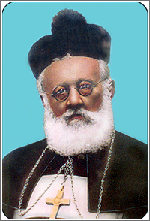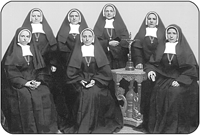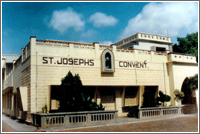History of JMJ in India – A New Era Begins for India |

His Grace Archbishop Aelen
|
Flame across the ocean
The establishment of the Society of J.M.J. in India began with the invitation from His Grace Archbishop Mgr. J. Aelen of Madras of which A.P. was a part. His grace had confidence that the sisters would help to develop the most backward area of A.P. Mill Hill missionaries were working in the Diocese, many of whom were Dutch, and this may have been the inspiration behind – the invitation of JMJs to India. |
|
 |
The valiant Women – Our Pioneers
Mother Seraphine Pullens was then the Superior General, Society of JMJ, Holland who was full of missionary zeal sent a team of seven missionaries Sr. Seraphique Kluten, Sr. Michaeli Schoten, Sr. Elizabeth Helsloot, Sr. Elza van de Helm, Sr. Lubuini Debets, Sr. Xaverini Gijsmen headed by Mother Stanisalus Terwindt bade goodbye to their kith and kin, and with little thought of a return to their Mother land set sail to India on 28th January 1904. |
 |
The first Founding House – St. Joseph's Convent, Guntur
With joy in their hearts, the Stalwarts landed on the Indian Soil in Bombay on February, 19th and finally arrived in Guntur their destined place on February 24th. Their first home was a small rented house in Nagaramplaem – Guntur. The mission expanded from the presence in Guntur to Vetapalam in May 1st 1905 this was later moved to Nellore in 1911 and Kurnool in 1913. Their beginnings in India started with the health ministry that the Dutch Sisters were very good at besides education of the girls. |
 The Native Daughters
The Native Daughters |
Indian Sisters as “Hand Maids” in the Society of JMJ
Many young girls offered themselves to live the way of the life of the JMJ Dutch Sisters. The lack of minimum education, the language barrier, the lack of religious training facilities, etc., prevented them from joining the JMJs directly. In 1907 with the approval of the Bishop of Den Bosch, Mother Seraphine Pullens in consultation of the ordinary of the Diocese, Bishop Aelen, the native congregation was started. They were called ‘Hand Maids' or ‘Ammagarlu'. |
A new chapter in the History of JMJ - India
Sr. Mary of the Sacred Heart (Dr. Sr. Mary Glowrey M.D.,) an Australian doctor joined the Society of JMJ in 1920 in Guntur and in 1923 a Tamilian lady from Madras Miss Isabel Swamikannu, B.A.L.T (Sr. Stanislaus Swamikannu Pillai) a first Indian member to join the Society of J.M.J. They both were the Stalwarts of the Education and Medical Apostolates of the Society JMJ, India. |
 Sr. Ethel helps Sr. Mary in Guntur
Sr. Ethel helps Sr. Mary in Guntur |
Wonderful are the ways of God's call – Australian Missionaries - India
In January 1932, a 42 year old doctor from Australia Sr. Veronica of the Holy Face entered the novitiate in Guntur and she worked with Sr. Mary Glowrey and in 1937 she was transferred to Bangalore. Later Miss Kathleen Monnaghan Australian nurse and Miss Margaret Barrett (Sr. Peter Julian), a Pharmaceutical Chemist in Malbourne joined the Society in 1947. In 1972 she returned to Australia to join the JMJ Community. |
‘Ammagarlu' join the JMJ Family
On 27th January, 1933 is recorded as a red letter day in the history of the Indian Province of all the International Congregations we could proudly say that it was the Society of JMJ a Papal Congregation that took initiative to accept Indian candidates to the Society. The first batch of 12 Indian Sisters as novices of the Society of J.M.J. was admitted at Guntur. Sr. Elzinio Luijken was the first novice mistress. In 1951 the formation house was shifted to Bangalore from Guntur. |
|
JMJs in the capital of Andhra Pradesh
In 1956 the State capital shifted to Hyderabad by then there were six communities in Andhra Pradesh. Sr. Jacquelini was the first Regional Superior from 1952 to 1958. Sr. Ferdinando Klassen succeeded her as Regional Superior in 1958. It was during her tenure that the JMJ presence in India was declared a Province.
The General Chapter of 1962 was a mile stone in the history of the Society. For the first time it elected an Indian Sisters as a General Councillor in the person of Sr. Stanislaus Swamikannu. It was this chapter that raised the Society of JMJ in India to the status of a province on 16th December with Sr. Ferdinando Klassen as its first Provincial Superior. JMJ expanded its presence to Raipur and Raigarh in Madhya Pradesh (now part of Chattisgarh). |
What a rapid growth !
In 1969, the Dutch Sisters handed over the reign to the Indian Sisters. Sr. Josepha Rachamalla took charge as the first Indian Provincial. During her term of office the Provincial House was shifted from Guntur to Hyderabad on April 28th, 1970. She was Provincial for two terms. There were 14 JMJ presences in three states, Andhra Pradesh, Karnataka and Madhya Pradesh. JMJ spread to 18 new presences in 12 years time and also expanded to Tamil Nadu during this time. Sr. Anna Maria Gali succeeded Sr. Josepha Rachamalla as the provincial superior in 1981. The expansion continued to Bihar (the present state of Jharkand).
The Indian Province was divided into three autonomous provinces namely Hyderabad, Bangalore and Guntur. They began functioning from 1st July, 1987. Sr. Anna Maria Gali, Sr. Joannette Mallavarapu and Sr. Rosina Antony were the first provincials respectively. The most important motive for this division was to solve the problem of covering long distances, which demanded great deal of energy and time. At the time of division, there were 39 presences in six states namely Andhra Pradesh, Madhya Pradesh, Bihar, Tamil Nadu, Karnataka and Kerala. |
|
|

